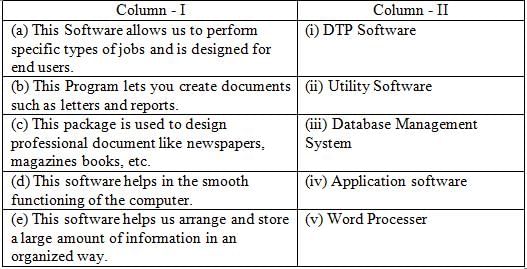Test: Fundamentals Of Computer- 3 - Class 5 MCQ
20 Questions MCQ Test Computer - Test: Fundamentals Of Computer- 3
A CPU processes the data and instruction provided through the input devices and then passes the processed result to the output devices. Identify the device on which it is present.
Which of the following is/are the hardware interfaces to connect devices to the computer?
What type of computer component may come in a dual-core version?
A/An _______________ software allows us to perform specific types of jobs and is designed for end users.
Utility software are programs designed to perform maintenance work on a computer system, so that the system can function smoothly. Which among the following is/are utility software?
(i) Word processing software
(ii) Disk defragmenter
(iii) Antivirus software
(iv) Desktop publishing software
Mozilla Firefox, Google Chrome and Apple Safari are all ________ software.
A language processor is a/an __________ that translates or converts a program written in a computer language into the machine language form, so that it can be understood by a computer.
Which of the following is NOT a, system software?
Which of the following programs might be used to send an Instant Message (IM)?
Which of the following is a function of an Operating System?
Which of the following is a system software that supports Graphical User Interface?
Which of the following is/are desktop publishing package?
A printed circuit board is a rigid, flat board that holds chips and other electronic components that are needed for a computer system. Which among the following is a PCB?
(1) Motherboard
(2) Memory modules
(3) Network interface
Which of the following components found inside the CPU box converts the incoming electricity into proper voltage and supplies it to other parts inside the CPU box?
Match the functions of software in Column-I with their respective names in Column-II.

A microprocessor is a small __________ that contains thousands of electronic components that store and process electrical instructions.
Which of the following devices has a cylindrical drum called a photo receptor?
|
33 videos|30 docs|32 tests
|


















